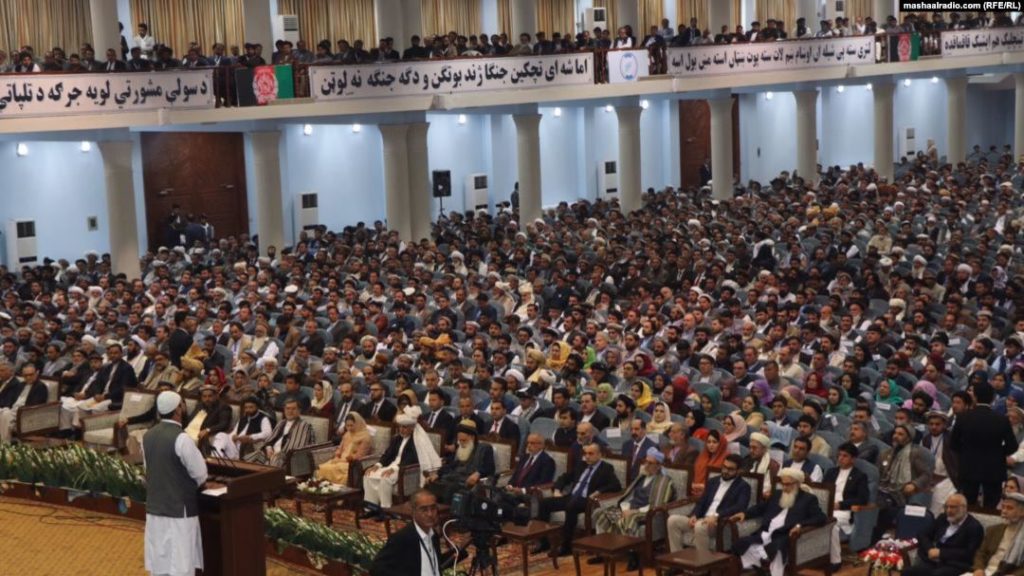Understanding President Ghani’s Peace Jirga
By Shershah NawabiAfghans know that peace and counter-terrorism mission in Afghanistan is inextricably entwined with international politics as also with Pakistan’s game of terror sponsorship.
Photo: RFE/RL

On the 29th of April the Afghan government convened the Consultative Peace Loya Jirga with the participation of 3200 representatives from all across Afghanistan. People from diverse groups, ethnicities, professions, as well as representatives from civil society, like journalists and social activists participated in the jirga to make their contribution in shaping a new faith and future for a country which has been at war for over 40 years of war with a fragile political and economic infrastructure. At least 35 percent of participants in this jirga were women. For the first time in Afghanistan’s history such a large number of women had gathered together under one roof to determine their future. The jirga continued over five days in a tight security environment without any interference from any insurgent group, including from the Taliban and ISIS-K fighters. Though there had been much political opposition and some high profile boycotts of the jirga, President Ghani, whose brainchild the jirga was, and the members of the High Peace Council were able to go ahead with this meeting smoothly. Finally, the jirga concluded with the adoption of a resolution. President Ghani then decided to use the jirga resolution as a roadmap of the Afghan government in peace talks with the Taliban.
The main demands that the jirga put forward, which also reflected the apparent redlines of all its participants were the following:
- An immediate end to the war with Taliban and imposition of a cease-fire,
- Withdrawal of all foreign forces and setting a timeline for such withdrawal,
- Maintain freedom of speech, as also all the achievements of the past 18 years, which includes maintaining and upholding all human rights, including the rights of women and children.
President Ghani once again demonstrated to his political rivals that he had the mind and courage to collect all Afghanistan citizens together and share the real issues of the country with them to hammer out a solution. As president Ghani said on the final day of the Peace Jirga: “I am honored with my respected and patriotic nation that they accept my invitation. I as the man in charge of this country give a blank cheque, but after five days of discussion my Afghan fellow country men and women have provided me a treasure full of success and bright future.” He also called on his rivals and those politicians who had boycotted this jirga – like former President Hamid Karzai and current CEO of the incumbent National Unity government Dr. Abdullah Abdullah – terming their decisions as incorrect. President Ghani highlighted: “Participation of 3200 representative showed that the motive and goal of this jirga is to find a roadmap and solution to the Afghan crisis, boycott of this jirga once again showed that Afghanistan political figures are still unexperienced because they did not respect well (decisions) of the Afghan citizens. Now our agenda has shown that we are on the right track and we will achieve peace in a short time.”
However, for many of President Ghani’s rivals, this jirga was perceived to be a part of the Afghan presidential palace plan to launch a massive and early election campaign. As Atta Mohammad Noor, Hizb-e-Jamyat Islami Chief Executive and a key figure of President Ghani’s political opposition wrote on his twitter page: “This peace jirga was a waste of money and also a maneuver of President Ghani to invite representative from all across Afghanistan and complete his electoral agenda. On this occasion let me to thank all the participants of this jirga who showed now we have reached a political consciousness and no one can misuse us.”
All of this points to the fact that this jirga was indeed a high profile highly publicized political outreach by President Ghani. The opposition equally upped the ante in condemning the event and act, imputing political and electoral motives to it.
However, for the majority of the citizens of Afghanistan, this jirga remained shameful and a dismal case as they know, and indeed as the world knows, that peace and counter-terrorism mission in Afghanistan is inextricably entwined with international politics – especially that between great powers – as also with Pakistan’s game of terror sponsorship. Hence, there is not much that the jirga will be able to accomplish on the ground in terms of facilitating peace and reconciliation in the country. Moreover, this jirga cost at least $ 5 million dollars at a time when Afghanistan still needs critical financial aid and support from the international community.
Therefore, as always, Afghan politics has shown that politicians are the only decision makers. This jirga once again demonstrated that self-interest and survival of Afghan politicians are placed higher than the national interest of Afghanistan. The future prospects and course of the Afghan peace process is still unclear and doubtful because the Taliban are emphasizing on continuing the violence, while the regional actors – Pakistan, China, Russia, Iran – have committed themselves to using the Taliban as a strategic tool against the US regional strategy in Afghanistan. Meanwhile, Pakistan once again shown its agenda, dealing with the Americans rather than with Afghanistan, reaching agreements whereby they would facilitate the Taliban’s presence at peace talks while also facilitating a free passage through its territory for withdrawal of US and NATO forces.
(The author is Editor-in-Chief, Pasbanan Media Group)